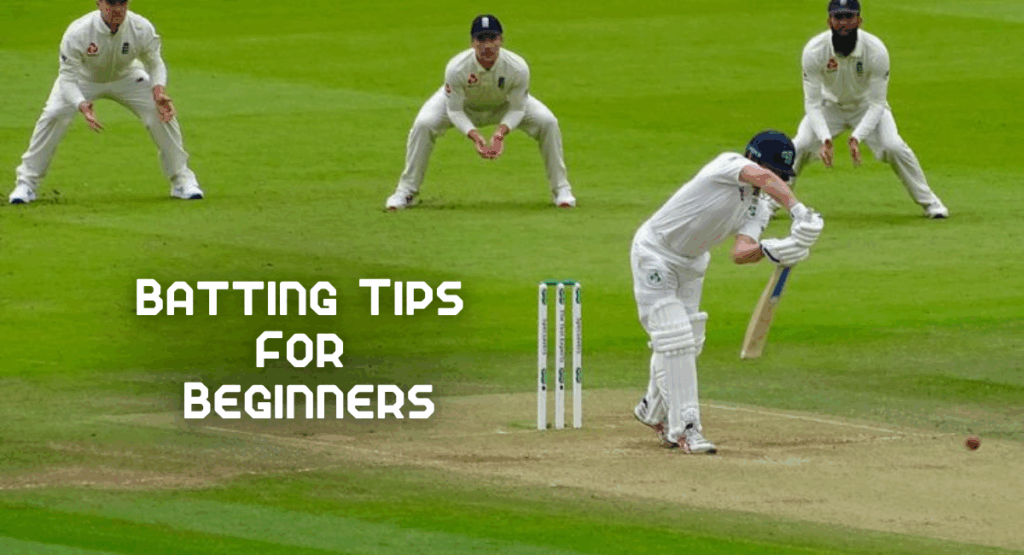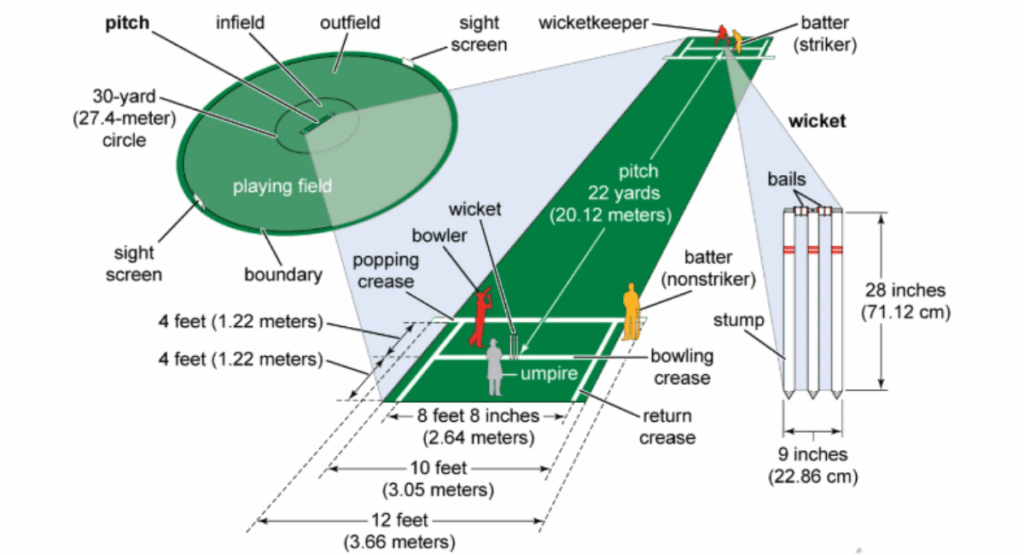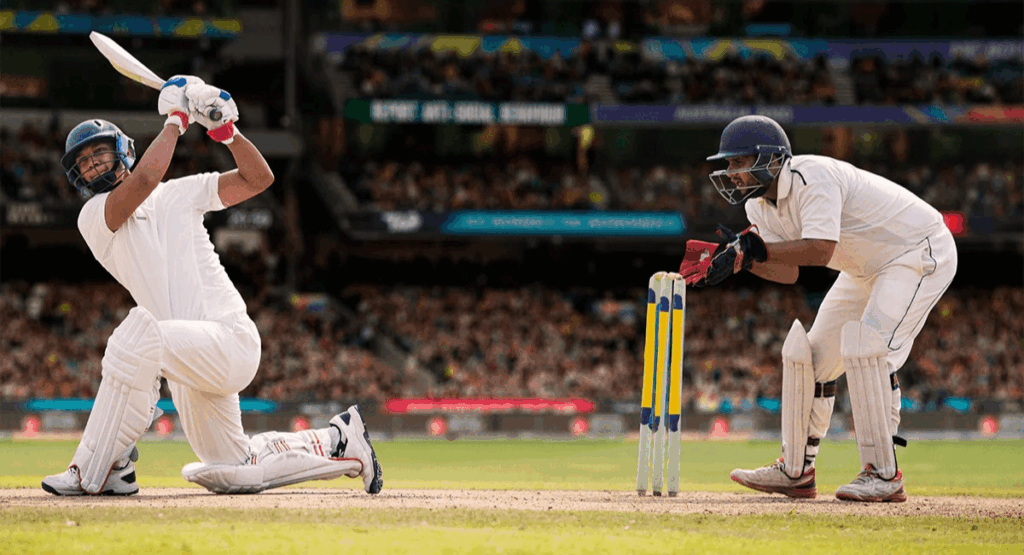Batting is one of the most exciting yet technical parts of cricket. For beginners, it may seem challenging at first, but with the right guidance and regular practice, you can quickly improve your game. This easy step-by-step guide shares the best batting tips for beginners to help you develop good habits, master basic techniques, and build confidence. Let’s start your journey to becoming a skilled and smart batsman.

Key Batting Tips for Beginners
The Batting Tips for Beginners guide starts with understanding the types of batting forms to be involved in. Before picking up the bat, it’s important to know that a batsman’s main goals are to score runs, protect the stumps, and stay at the crease for as long as possible. Depending on the game situation, you can choose to bat defensively to stay safe or go on the attack to score more runs. Choosing the right equipment, such as a proper bat, gloves, pads, helmet, and guard, not only keeps you safe but also helps improve your control. Once you’re familiar with these basics, you’ll be ready to move on to more technical steps.
Step 1: Master the Correct Grip
Now that you know the basics, the next step is learning how to hold the bat correctly. Your grip affects your shot control, balance, and power, so getting this right is essential. To get a good grip on the bat, place your top hand near the top of the handle and let your bottom hand rest gently just below it. Make sure the “V” shapes formed by your thumbs and index fingers are pointing down the back of the bat. A relaxed grip gives your wrists more freedom to move, which is helpful for playing different types of shots. Keep practicing this grip to make it feel natural.
Step 2: Perfect Your Batting Stance
Once your grip is set, you need a solid stance to stay balanced and ready. A good stance helps you react quickly to the ball and play shots with control. Stand with your feet about shoulder-width apart, keep your knees slightly bent, and make sure your head is still. Keep the bat resting behind your back foot and focus your eyes on the bowler. Your shoulders should remain relaxed to avoid stiffness. Practicing this stance regularly, even in front of a mirror, can help you improve posture and maintain good balance during matches.
Step 3: Focus on Footwork
With the grip and stance in place, your next focus should be footwork. Good footwork helps you reach the ball in the right position and play cleaner, more accurate shots. You’ll need to move your front foot forward for full-length balls and your back foot backward for shorter ones. This movement also helps you keep your balance and shift your body weight properly. Use drills like cone exercises and shadow batting to build speed and precision. As you improve, your shot selection and timing will also get better.
Step 4: Learn Shot Selection
After developing solid footwork, it’s time to understand when and how to play the right shot. Shot selection is one of the most important parts of batting because it helps you stay safe while scoring runs. Learn basic cricket shots like the forward defense, cover drive, pull shot, and square cut. Choose your shot based on the line, length, and speed of the delivery. Instead of swinging at every ball, be selective and play each one with a clear plan. Over time, smart shot selection can help you build longer, more successful innings.

Step 5: Train Your Eye-Hand Coordination
As you work on your shots, you must also train your eye-hand coordination. This skill helps you track the ball from the bowler’s hand and connect the bat with perfect timing. Keep your eyes glued to the ball, right from the moment it’s released until it lands in your hands. Practice drills like the hanging ball or bounce-back wall drills to sharpen your reactions. Using soft balls at home can also help you work on quick reflexes. With better coordination, you’ll start to play more confidently against faster bowlers.
Step 6: Practice Running Between the Wickets
Let’s take a moment to appreciate just how crucial it is to run between the wickets. Good running adds quick runs to the scoreboard and helps keep the pressure on the opposition. Always communicate with your batting partner using calls like “yes,” “no,” or “wait” to avoid runouts. Ground your bat properly when turning or diving into the crease. Also, practice turning quickly after each run and learn how to judge when to go for a single or double. As your awareness improves, your running will become sharper and more efficient.
Step 7: Build Mental Toughness and Focus
Batting is not just physical; it’s a mental game too. Building mental toughness helps you stay focused, especially in high-pressure situations. Instead of getting discouraged after a bad shot or dismissal, learn from it and move on. Imagine taking a moment to visualize your shots and get in the right mindset before each ball. It’s all about that mental preparation! Stay calm and composed, no matter what the bowler is doing. With time, you’ll develop patience and confidence, which are the signs of a mature and dependable batsman.
Step 8: Common Beginner Mistakes to Avoid
As you continue learning, it’s important to avoid common beginner mistakes that can slow down your progress. For example, gripping the bat too tightly makes your wrists stiff and reduces control. Swinging at every ball without watching its line or length can lead to early dismissals. Also, focusing too much on power instead of timing can cause mistimed shots. Always keep your head still and eyes on the ball. By correcting these mistakes early, you’ll become a more technically sound player.
Step 9: Drills and Practice Routines for Beginners
Practicing regularly is the only way to improve your batting skills. Create a weekly schedule that includes time for shadow batting, footwork drills, shot practice, and coordination exercises. Try to practice at least 30-45 minutes a day, focusing on one skill at a time. Capture your practice sessions so you can analyze your technique and identify areas where you can improve. Consistency is key; small efforts daily lead to big improvements over time. Also, practicing with a friend or coach can give you useful feedback.
Conclusion
Starting in cricket can be both exciting and overwhelming, but with the right guidance, you can grow your skills quickly. These step-by-step batting tips for beginners are designed to help you master the fundamentals and avoid early mistakes. Keep practicing regularly, stay patient, and focus on improving one skill at a time. With dedication and the right mindset, you’ll soon be hitting your way to better innings.

FAQs: Batting Tips for Beginners
What is the best way to hold the bat and stand while batting?
If you’re just starting, the best way to hold the bat is by placing your top hand near the top of the handle and your bottom hand loosely below it. Make sure your hands form a “V” shape pointing down the back of the bat. For your stance, stand with your feet shoulder-width apart, bend your knees a little, and keep your head still.
How can I improve my footwork in batting?
Good footwork helps you reach the ball easily and play better shots. To improve it, practice moving your front foot forward for full balls and your back foot backward for short ones. Try simple drills like stepping over cones or shadow batting at home. The more you practice, the faster and smoother your footwork will get.
Should I learn defensive shots or attacking shots first?
Start with defensive shots. They help you stay safe and protect your wicket when you’re still learning. Once you get comfortable blocking the ball, you can slowly start practicing attacking shots like drives and pulls. Building a strong defense makes you a better batsman in the long run.
Can I practice cricket batting alone at home?
Yes, you can! Even without a cricket pitch, you can do shadow batting in front of a mirror to check your stance and movements. Try hitting a hanging ball to improve your timing. You can also bounce a tennis ball off a wall to work on your hand-eye coordination. These small drills make a big difference.
Why is it important to watch the ball closely while batting?
Watching the ball from the bowler’s hand to your bat helps you time your shots better. If you look away too early, you might miss the ball or hit it poorly. Keeping your eyes on the ball gives you more control and helps you react better, especially against fast bowlers.
What protective gear should beginners wear while batting?
Safety is very important, especially when you’re new. Always wear a helmet to protect your head, pads for your legs, gloves for your hands, and a guard (box) for your body. When you’re protected, you can focus more on playing and worry less about getting hurt.

